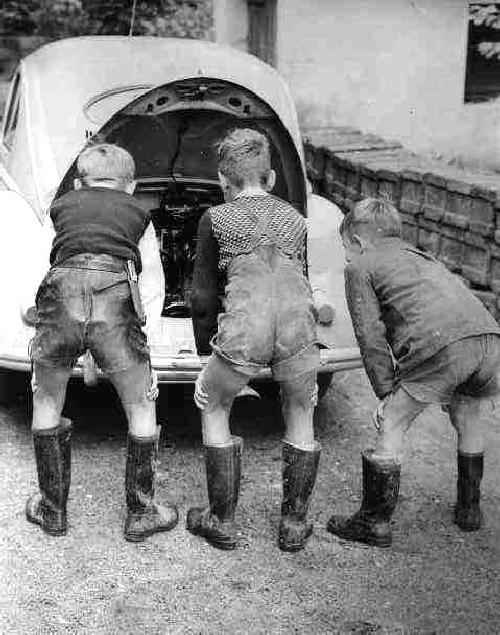
Boys' 1940s Pants and Trousers: Country Trends--Germany

Figure 1.--Ferdinand Porche designed the Volkswagen in the 1940s before World war II. It was never built in quantities, however, until after the War. It became the center-piece of the German post-War economic miracle. Here we see three German boys examining a new VW. Lederhosen became increasingly populafr in Germany after the War in the 1940s. Here two boys wear Lederhosen which was a very flexible garment. Lederhosen might be worn for outdoor play like the boys here. They were also worn for school and for dressing up and notvjust with Bavarian jackets.
|
Short pants continued to be widely worn by German boys in the 1940s, although we also see boys wearing ski-pants, knickers, and long pants. Here a variety of seasonal, age, and social class factors were involved. World War II occurred in the first half of the 1940s. The War and Germany's defeat and post-War occupation had a major impact on fashion, including the types and styles of pants worn. Clothing styles did not immediately change after Germany's defeat an occupsation (1945). The devestation resulting from the War did affect how children were dressed and this did not begin to change until the post-War recovery began (1948). Short pants worn with long stockings continued to be a major style for German boys. On a wintry day in 1948 during the American occupation of one sector of Germany, for instance, we see a German boy befriended by a G.I. The boy wears quite long short pants with heavy woolen long stockings and a stocking cap.
Another shot taken in West Germany the same year shows a German boy of about 12 cleaning an American officer’s car. He wears short pants, long stockings, and a beret.
During the Berlin Air Lift in 1948-49 German boys welcomed American soldiers who were in a position to give them candy and other goodies. This photo shows German boys dressed in a variety of clothes. One boy wears shorts with knee socks, another wears suspender shorts (cut quite short) with long brown stockings, and a third boy, only slightly older, sports long trousers. Most German mothers seem to have felt that boys should not wear long trousers until about 13-14 years of age, although more mothers were buying ski-pants or long pants for the winter. .
In East Germany after 1945 as the Cold War developed , styles of boys’ clothes were very conservative, and most boys seem to have worn their short pants with long stockings, at least in the chillier seasons. In one photo, for instance, we see an East German boy of about 11 or 12 wearing very dark shorts with the H-bar suspenders and black long stockings. With his white shirt, he seems to be quite dressed up for the political parade he is watching.
About the same time in West Germany most boys were wearing short pants of some sort rather than knickers. We have an image of a German lad in lederhosen held up by the traditional H-bar leather suspenders. Most boys wearing lederhosen wore them with knee socks, although some boys wore them with long stockings or ankle socks. In the present case, we can’t tell what sort of hosiery is involved.
HBC

Navigate the Historic Boys' Clothing Web Site:
[Return to the Main 1940s trouser country page ]
[Return to the Main trouser type chronology page]
[Introduction]
[Activities]
[Biographies]
[Chronology]
[Cloth and textiles]
[Clothing styles]
[Countries]
[Topics]
[Bibliographies]
[Contributions]
[FAQs]
[Glossaries]
[Satellite sites]
[Tools]
[Boys' Clothing Home]
Navigate the Historic Boys' Clothing Web chronological pages:
[Early 19th century]
[Mid-19th century]
[The 1860s]
[The 1870s]
[The 1880s]
[The 1890s]
[The 1900s]
[The 1910s]
[The 1920s]
[The 1930s]
[The 1940s]
[The 1950s]
[The 1960s]
[The 1970s]
[The 1980s]
Navigate the Historic Boys' Clothing Web style pages:
[Skeleton suits]
[Eton suits]
[Norfolk jackets]
[Kilts]
[Knicker suits]
[Blazers]
[Short pants suits]
[Long pants suits]
Created: 11:51 PM 2/18/2006
Last updated: 11:51 PM 2/18/2006


